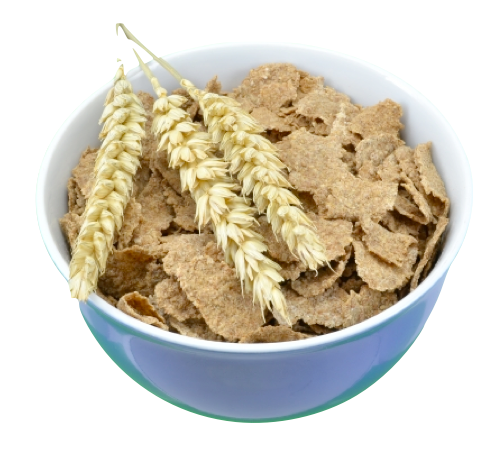 You’ve heard it before: bran is an excellent source of fiber. Raisins are healthy. ‘My parents eat it, so it must be nutritious.’
You’ve heard it before: bran is an excellent source of fiber. Raisins are healthy. ‘My parents eat it, so it must be nutritious.’
Ah yes, the infamous Raisin Bran health myth.
And what about Mini-Wheats? To the untrained eye, they look like little packets of good health; after all, aren’t they just kid-sized versions of that wholesome, whole-grain cereal of the turn of the twentieth century, Shredded Wheat?
These two cereals, which make up a large portion of Kellogg’s market share every year, are maybe not as virtuous – nor as different – as we think.
It’s time to undress Raisin Bran and Frosted Mini-Wheats and compare them!
Here’s how the ingredients break down in each:
Raisin Bran: whole grain wheat, raisins, wheat bran, sugar, brown sugar syrup, salt, malt flavor, plus a cocktail of vitamins and minerals
Frosted Mini-Wheats: whole grain wheat, sugar; 2% or less of brown rice syrup, gelatin, BHT
Well, all things considered, these don’t look so bad. The list of ingredients doesn’t run on for miles and everything is quasi-identifiable as its own food: we could go out and purchase most of the individual components separately.
Even the claims on the packaging are quite enticing. Frosted Mini-Wheats are promoted for fiber content, while Raisin Bran is labeled as “a good source of potassium”. Both are touted as “whole grain” cereals. Mini-Wheats are actually called ‘eight layers of whole grain’, whatever that means. (Nutritional quality isn’t usually measured in layers, in case anyone was keeping track.) Fiber and grains that have everything we need? In one convenient box? It sounds too good to be true!
And it is.
Let’s start with sugar.
According to the 2012 Investor Report released by Kellogg’s, Mini-Wheats are considered a great breakfast choice because of their low sugar content (just 12 grams!) and low sodium content (5 milligrams) per serving.
A gram is roughly equivalent to the weight of three green peas, so twelve grams sounds pretty miniscule. But when we consider that a child’s daily-recommended intake of sugar (3 teaspoons, or 12 grams) would be satisfied with half a cup of Mini-Wheats, it paints a different picture.
Often times when you look at the packaging and picture of children’s cereal brands you can tell they are full of sugar, however, what about cereals that aren’t so obvious? Let’s take a look at the list of ingredients in Raisin Bran again: how many references to sugar can you spot? (Hint: sugar makes up more than half the total number of ingredients in the box). Raisin Bran actually scores worse than Mini-Wheats when it comes to sugar content. Interestingly, Raisin Bran is supposed to appeal to grown up tastes (read: less sweet)? Apparently not: one serving of this classic has 18 grams of sugar! That’s pretty close to the recommended daily sugar intake of 20 grams for adult women and about half the 36 grams recommended for men.
Here’s the pickle with this: starting the day with a bowlful of sugar actually sets us up to make more unhealthy food choices throughout the day. When our first meal of the morning causes our blood sugar to spike and crash, we are more likely to spend the rest of the day hungry and look for continuous short-term fixes for this. Because carbohydrates are the quickest answer to hunger, we’re more likely to go after additional refined starches and sweets throughout the day to curb the constant up-and-down of our blood sugar. As a continent, we eat nearly 180 pounds of sugar per person per year – that’s half a pound, or 54 teaspoons, of sugar per day. One bowl of Raisin Bran provides our first 3 teaspoons of the day — and that’s if we stick to the 1-cup serving size.
Perhaps not so virtuous afterall.
What about the ‘whole grain’ claims?
We could expect that a product labeled ‘whole grain’ would have a complement of nice nutrients and health benefits, but the labelling laws for grains in Canada are quite lax – and a little misleading. Before arriving to us in those familiar boxes, the wheat in these Kellogg’s products goes through an intense refining process to make it more shelf stable and more easily manipulated into layers of ‘whole grain’ goodness. Before milling, wheat is sorted and conditioned – that is, soaked and heated to soften the outside shell. It is then run through a complex set of rollers that separate the bran (fibre) and the germ (containing beneficial vitamins, nutrients, and healthy fats) from the endosperm (the starchy inside). Different sized rollers are used depending on the bran:endosperm ratio the manufacturer is looking to create.
Removing the germ increases shelf life, as the fat can go rancid over time. (See more below on preservatives.) More endosperm and less bran creates a whiter, starchier flour that, although easier to form into shreds and flakes, is much lower in nutritional value. Federal food regulations allow for removal of up to 70% of the germ and bran in products labeled ‘whole grain’, meaning these cereals can have only 30% of the bran and germ intact and still be marketed as nutritious. In fact, they aren’t much better nutritionally than refined white flour. The difference between wheat that has been processed this way, versus blending your own whole grains in a food processor is that blending doesn’t remove nutrients: it just breaks them into smaller pieces. They’re still available to the body.
The wheat in these cereals is really not a whole grain at all. Another good indicator of this is the cocktail of vitamins and minerals tossed back into the mix. If the grains were in fact whole – retaining all of the naturally occurring good stuff – the manufacturer would not need to add these back in synthetically.
What about that BHT? What the heck is that?
One other thing to notice on the Mini-Wheats label is BHT, or butylated hydroxytoluene. This is a preservative added to packaging to prevent oils from going rancid by preventing bacteria and pathogens from living inside the box. It preserves color, odor, and flavor. It is also fat-soluble, so while it’s not added directly to the food, it can be taken up by the naturally-occurring fats in the grain itself (those fats being the reason BHT must be added to the packaging to begin with). Like many other food additives, there is not a ton of research showing the long-term effects of exposure to BHT-contaminated foods, so it’s best to avoid it whenever possible.
Sugar. Refined grains. Preservatives. Kid cereal or adult cereal, these are the foundation of both of these products when we get right down to it.
As any avid reader of The Naked Label knows, things in packages can be a minefield of potentially problematic, not-so-great-for-us ingredients. Keep reading those labels, and consider swapping in some truly whole grain options in place of commercial breakfast cereals.
Whole grains contain all the components of the grain and have not been refined or broken into various parts. They retain the beneficial nutrients (like Vitamin E), healthy fats, and protein, instead of milled versions that are stripped down starches. When they are refined they don’t make for complete foods, so we are more likely to be missing out on essential nutrients that only whole foods can provide. When we eat foods that are incomplete, the body doesn’t register satiety in the same way. It interprets partial foods as missing something, and just like with sugar, we’re more likely to spend the rest of the day in search of snacks to fill the nutritional gap.
Cooked quinoa, millet, brown rice, or oats make a fabulous breakfast, hot or cold, combined with your milk of choice (I love homemade almond milk), and a combination of nuts, nut butter, berries, dried apple, or fresh fruit. Toss in some spices like cinnamon or nutmeg and those days of craving sugar-covered wheat flakes will be a distant memory. Thank goodness!
Here’s one of my favorite homemade cereal recipes – super quick, super portable, and won’t go soggy like certain other packaged options:
Recipe: Powerhouse Cold Oats
Ingredients:
½ cup raw rolled oats
1 tsp coconut oil
1 tbsp almond butter
½ cup almond milk
sprinkle of cinnamon
Instructions:
Combine oats, coconut oil, and nut butter in a small bowl. Stir to combine. Top with almond milk and cinnamon. Serve cold.
Feel like protecting your friends and family from getting tricked into thinking these cereals are healthy? Click the share buttons below to help us spread the word!
 At The Naked Label we love Amy’s tell-it-like-it-is approach to holistic nutrition! Why hide the goods? You’ll want to check out her site for even more HOT info that she’s cookin’ up on the daily. Click Here to check out Amy’s site.
At The Naked Label we love Amy’s tell-it-like-it-is approach to holistic nutrition! Why hide the goods? You’ll want to check out her site for even more HOT info that she’s cookin’ up on the daily. Click Here to check out Amy’s site.
“Image courtesy of Grant Cochrane / FreeDigitalPhotos.net”.
Sources:
Wheat Milling at the Grain Research Laboratory: http://www.grainscanada.gc.ca/research-recherche/izydorczyk/cwmgrl-lrgmbc/cwmgrl-lrgmbc-eng.htm
Milling Operations: http://www.nelstrop.co.uk/milling-operations
Why Whole Grain Claims Aren’t Always as Healthy as They Seem: http://www.theglobeandmail.com/life/health-and-fitness/health/why-whole-grain-health-claims-arent-always-what-they-seem/article4461182/
Fructose: http://articles.mercola.com/sites/articles/archive/2010/04/20/sugar-dangers.aspx


